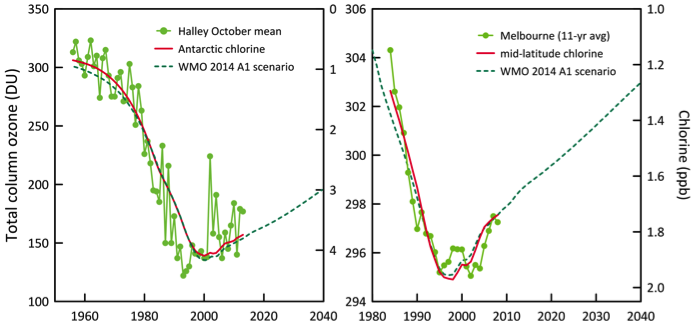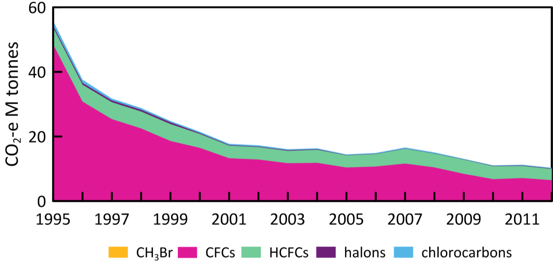KEEP UP THE GOOD WORK
- PostedPublished 5 December 2016

THE phase-out of CFCs and HCFCs, improvements to equipment and installations, reduced leakage rates and the recovery and destruction of contaminated and unwanted refrigerant has produced a massive reduction in carbon dioxide equivalent (CO2-e) emissions by the refrigeration and air conditioning industry.
As regular readers of SightGlass News know, the phasing out of CFCs such as R12 has resulted in a reduction in the destruction of the ozone layer, meaning the ‘Hole’ will diminish over time and the level of harmful UV radiation will decline. The improvement can already be seen in testing undertaken by the CSIRO.
Ozone-depleting substances (ODS) will be almost completely phased out by 2030 under the Montreal Protocol that was signed in 1987 and is celebrated as the most successful international environmental agreement in history.
The Montreal Protocol has already achieved a phase-out of CFCs in all countries, with the next target being HCFCs. Australia phased out CFCs in 1995.
While developed nations including Australia have reduced HCFC consumption by more than 90 per cent, developing countries have just commenced their phase-out and will complete that program by 2030.
For comparison, the HCFC R22 has only 5 per cent the ozone-depleting potency of the now banned CFC R12 and has a much shorter atmospheric life.
But the long atmospheric life of some ODS means it will take much of this century for them to be cleaned out of the atmosphere for good.
A less understood part of the global ODS ban was its impact on reducing the emission of greenhouse gases.

It is estimated that the equivalent of more than 100 billion tonnes of CO2 has been prevented from emission due to the Montreal Protocol, making it more effective than the first commitment period of the Kyoto Protocol, an international agreement specifically designed to reduce greenhouse gas emissions.
One kilogram of R12 released to atmosphere has a CO2-e of 10,000kg. For comparison, a kilo of R134a is 1360kg CO2-e, otherwise known as global warming potential (GWP).
Recently it was agreed to extend the Montreal Protocol to include a phase-down of HFCs with high GWP, including R134a.
Because HFCs were introduced to transition away from ozone-deleting refrigerants, consumption and emissions are still growing.
The success of the Montreal Protocol in phasing out CFCs and HCFCs helps us build a picture of how including HFCs in the agreement will help our industry lead the charge toward a low carbon emissions future.
Here we are using data from the CSIRO, which operates a world-class atmospheric research facility at Cape Grim on the northwest tip of Tasmania and combines these readings with analysis of Antarctic firn (ice-cores).
The great news is that recovery of the ozone layer has commenced over Antarctica and Australasia, and it will be fully recovered towards the middle of this century.
Stratospheric ozone is destroyed by some halogens, such as chlorine, that are carried into the upper atmosphere as a component of CFC refrigerants and Halon fire suppressants. It’s pretty much a zero sum situation, the more chlorine the less ozone.
Now that chlorine levels are declining the ozone layer has commenced regenerating to act as a more effective shield for harmful UV radiation.
R12 was responsible for delivering much of the chlorine to the stratosphere. The stability of the molecule gave it a long atmospheric life that enabled its transport to the upper atmosphere where it broke down thereby releasing chlorine to react with ozone.

Since the phase-out of CFCs the amount of R12 in the atmosphere has peaked and begun to decline.
Emissions are substantially down and continue to decline at the rate of seven per cent each year.
If we can replicate this success with the HFC phase-down, our industry can again be associated with one of the most significant environmental triumphs. Twice in one generation is not bad.
Because HFCs will be around for a long time yet, it remains important to avoid emissions whenever possible.
You are making a difference by continuing to ensure systems are well maintained and applying best practice when handling refrigerants, including recovering contaminated and unwanted refrigerant for safe destruction.
As shown in the graph below, Australian industry has already reduced direct greenhouse gas emissions by 85 per cent and will deliver a further reduction of 85 per cent under the agreed phase-down described in the amended Ozone and Synthetic Greenhouse Gas Act.
We just need to keep up the good work.
- CategoriesIn SightGlass
- TagsSightGlass News Issue 8

